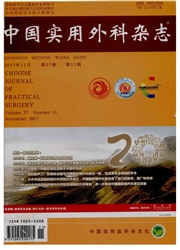

 中文摘要:
中文摘要:
目的评价中国《结直肠癌肝转移诊断和综合治疗指南(V2010)}中关于肝转移灶手术指征扩大后安全性和对病人生存的影响。方法将复旦大学附属中山医院2000—2010年收治的530例行结直肠癌肝转移灶手术切除的病人.按采用的肝转移灶手术指征不同将病人分为2000—2004年和2005—2010年两组,回顾性评价和分析两组病人的临床资料和生存状况。结果2005—2010年肝转移灶手术指征扩大后,手术切除率从2000—2004年的25.1%升至35.1%(P〈0.05);病人术前血清CEA和CAl9—9水平明显升高;围手术期病死率(2.2%VS.0.9%)和并发症发生率(20.9%vs.29.8%)两组差异无统计学意义,但并发症发生率有一定升高趋势。两组病人术后复发率分别为27.5%和36.7%,5年总体存活率分别为43%和49%,中位生存时间分别为43.7个月和55.7个月,差异均无统计学意义。结论中国《结直肠癌肝转移诊断和综合治疗指南(V2010)}}中关于肝转移灶的手术指征安全可行,显著提高了手术切除率,使更多病人获得了治愈的希望,值得推广。
 英文摘要:
英文摘要:
Objective To ascertain the short-term and long-term outcomes of expanding criteria for resectability of colorectal liver metastases (CRLM) from Chinese Guidelines for the Diagnosis and Comprehensive Treatment of Hepatic Metastasis of Colorectal Cancer (Version 2010). Methods The data of 530 consecutive CRLM patients underwent hepatectomy between 2000 and 2010 in Zhongshan Hospital of Fudan University were analyzed retrospectively. Patients were divided into two groups according to different resectability criterias (group I: 2000-2004; group II: 2005-2010). Mortality, morbidity and survival rates were evaluated. Results After the expansion of resectability criteria, hepatectomy rate increased from 25.1% to 35.1% (P〈0.05). Patients in group II presented with higher preoperative serum CEA and CA19-9 levels. Although perioperative mortality (2.2% in group I and 0.9% in group II) and morbidity (20.9% in group I and 29.8% in group II) were observed with no significant difference between two groups. But there was a trend toward a higher morbidity was observed in group II. In addition, there was no significant difference in recurrence rate (27.5% in group I and 36.7% in group II) or overall survival (43.7 months in group I and 55.7 months in group II; 5-yearsurvival, 43% and 49% ). Conclusion The favorable short-term and long-term outcomes justify an expansion of the criteria for respectability in Chinese Guidelines for the Diagnosis and Comprehensive Treatment of Hepatic Metastasis of Colorectal Cancer (Version 2010).
 同期刊论文项目
同期刊论文项目
 同项目期刊论文
同项目期刊论文
 Self-expandable metallic stent placement plus laparoscopy for acute malignant colorectal obstruction
Self-expandable metallic stent placement plus laparoscopy for acute malignant colorectal obstruction The results of surgery for colorectal hepatic metastases following expansion of the indications in 2
The results of surgery for colorectal hepatic metastases following expansion of the indications in 2 Predicting metachronous liver metastasis from colorectal cancer using serum proteomic fingerprinting
Predicting metachronous liver metastasis from colorectal cancer using serum proteomic fingerprinting Aberrant expression of sphingosine-1-phosphate receptor 1 correlates with metachronous liver metasta
Aberrant expression of sphingosine-1-phosphate receptor 1 correlates with metachronous liver metasta 期刊信息
期刊信息
